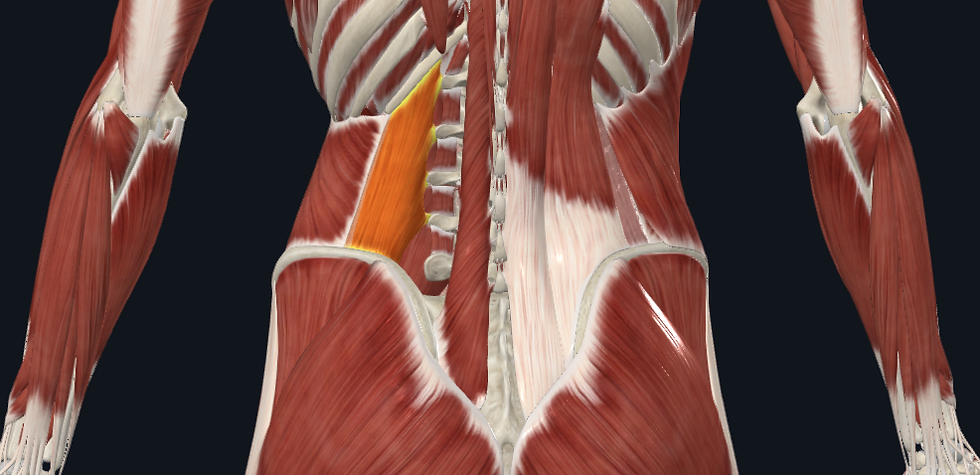Behind the Muscle Pain Part 3: Quadratus Lumborum
- Kyle Conatser
- Aug 3
- 4 min read
Understanding muscle pain often feels daunting, but it is essential for anyone seeking relief and better health. In this third part of our series "Behind the Muscle Pain," we explore the Quadratus Lumborum muscle (QL). This often-overlooked muscle plays a significant role in your lower back. We'll examine why it becomes tight, the complications that arise, and how therapies like Neural Reset Therapy and Massage Therapy can offer much-needed relief.
What is the Quadratus Lumborum?
The Quadratus Lumborum is a thick, quadrilateral muscle found in the lower back. It connects the iliac crest of the pelvis to the lower ribs and lumbar vertebrae. This muscle is vital for several movements, such as bending to the side (lateral flexion of the spine), stabilizing the pelvis, and promoting deep breathing by anchoring the lower ribs.
Due to its intricate role in maintaining posture and body alignment, the health of the QL is crucial for overall well-being.
Common Reasons Why the Quadratus Lumborum Gets Tight
Tightness in the Quadratus Lumborum can be attributed to various factors. Understanding these causes is vital for effective prevention and management.
1. Poor Posture
Long hours of sitting, especially in a slouched position, create muscle imbalances and strain in the QL. Studies show that more than 60% of people who sit for prolonged periods experience lower back discomfort. As the body remains misaligned, the QL often works overtime to compensate, leading to tightness.
2. Physical Activity
Engaging in strenuous physical activities without adequate warm-up can stress the QL. For instance, activities involving heavy lifting or twisting can overexert this muscle. According to statistics, 30% to 40% of individuals who participate in intense fitness routines report muscle tightness in this area.
3. Emotional Stress
Stress can lead to physical tension. Many individuals tend to hold stress in their lower back and hips, causing chronic tightness in the QL. A survey indicates that 42% of adults report experiencing muscle tension related to stress.

Common Issues Caused by a Tight Quadratus Lumborum
Chronic tightness in the QL can lead to various complications:
1. Lower Back Pain
Persistently tight QL muscles are a common cause of lower back pain. This pain may be localized or radiate into the buttocks and legs. Research indicates that 80% of the adult population will experience lower back pain at some point in their lives.
2. Increased Risk of Injury
Tightness in the QL can affect movement patterns, increasing the likelihood of injuries during physical activities or daily tasks. Individuals with tight QL muscles are twice as likely to report injuries when engaging in sports activities.
3. Hip and Leg Pain
The QL is closely linked to the pelvic area, and tightness can result in discomfort that radiates to the hips and legs, which can mimic sciatica symptoms.
How Neural Reset Therapy and Massage Therapy Can Help
For those experiencing a tight Quadratus Lumborum, holistic approaches like Neural Reset Therapy and Massage Therapy can provide substantial relief.
Neural Reset Therapy
Neural Reset Therapy (NRT) operates on the idea that muscles can reset their tension levels through appropriate stimulation. By targeting specific neuro-muscular pathways with, NRT helps deactivate overly active muscle reflexes in the QL, offering immediate relief. This gentle therapy effectively addresses discomfort rooted in neural patterns rather than just muscular issues.
Massage Therapy
Massage Therapy serves as an invaluable approach to relieving QL tightness. Techniques like deep tissue massage and myofascial release can alleviate tension, enhance blood flow, and promote relaxation in the muscle. In therapy sessions, professionals often use the following methods:
Trigger Point Therapy: Targets specific tight areas within the muscle.
Myofascial Release: Focuses on surrounding fascia to reduce overall tension.
Stretching Techniques: Introduces movements to elongate muscle fibers and boost mobility.

Practical Ways to Release the Quadratus Lumborum
Incorporating self-care strategies can help keep the Quadratus Lumborum relaxed and avoid tightness. Here are practical methods:
1. Stretches
Performing targeted stretches can effectively lengthen the QL. Side bends, where one arm is raised over the head while leaning to the opposite side, work exceptionally well for this muscle.
2. Strengthening Exercises
Enhancing your core and surrounding muscle groups can alleviate reliance on the QL. Exercises like planks and side leg raises are great for building strength and stability.
3. Mindfulness and Breathing Exercises
Engaging in mindfulness and deep-breathing techniques can relieve emotional stress and promote lower back relaxation. Practitioners have noticed a 30% decline in muscle tension after consistent mindfulness practices.

Final Thoughts
The Quadratus Lumborum may seem small in the broader anatomy context, but its impact on our daily lives is significant. By recognizing the common triggers for tightness and the symptoms it produces, individuals can manage their discomfort effectively.
Methods like Neural Reset Therapy and Massage Therapy greatly enhance recovery and relaxation. When combined with preventive techniques like stretching and strengthening, maintaining the health of your QL becomes a realistic goal.
Stay tuned for the next installment in our series "Behind the Muscle Pain." We will continue exploring the interesting world of muscle function and pain management. Whether you're an athlete, office worker, or anyone in between, understanding how your body functions is the first step toward a pain-free life.
Unlock the Freedom of Movement!
Are you ready to liberate your Quadratus Lumborum and embrace a life with less pain? Click the buttons below to embark on your transformative journey towards greater mobility and comfort. Your path to freedom starts now!





Comments